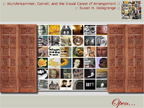When Revision Is Redesign: Key Questions for Digital Scholarship
Susan H. Delagrange
Motion
Q: How can the sequencing and mobility of the images and the text be redesigned to foreground the primacy of heuristic vision in a digital landscape?
Motion is the quality of the Wunderkammer that most defines its function as a knowledge structure, and that best exemplifies the mobility of the canon of arrangement. From the start, whenever I thought about this project, or explained it to someone else, I invariably ended with "...and it has to move."
Arrangement has always been about moving things around—flowers in a vase, specimens in a case, paragraphs in an essay, evidence in a trial. When I teach argument, I ask my students to find visual and audible materials, as well as written, during their research. Then we literally move the evidence around, creating a series of relationships and associations, and exploring the meanings and conclusions that develop from those associations. Using this process, arrangement is not deferred until after theses have been developed and conclusions drawn; rather it takes an active place as an important component of invention. (I go into greater detail on this process in "Praxis," the final section of "Wunderkammer.")
The physical mobility of objects in a Wunderkammer, and the cognitive mobility that the process of analogical visual troping implies, both foster associative habits of mind that can be equally well employed in the construction and manipulation of digital media designed as technologies of wonder and discovery.
Discussing creativity and memory, Jason Lehrer (2009) wrote, "From the perspective of the brain, new ideas are merely several old thoughts that occur at the exact same time" (p. xiv). Cognitive research supports the assertion that the brain is less computational than combinatorial, working through homology and affinity in a search for similarities (Stafford, 2001, pp. 47-48, 139-142). It makes sense, then, that new knowledge can be generated by the discovery of meaning in unexpected juxtapositions, and that those juxtapositions will be stimulated by wandering and wondering through a richly furnished imaginative space.
That said, the most significant flaw in the first version of "Wunderkammer" was the way it moved. More specifically, images were put into motion in the first version when the viewer moused over words or phrases called out in red in the text. I think I recognized that there was a problem, but I didn't understand what it was until I was attempting to make the 2009 version more Wunderkammer-like. Then it hit me. Interacting with a Wunderkammer is a concrete, sensory experience of manipulating the contents into meaningful arrangements. It relies first on sight, and secondarily on touch, sound, and smell. This embodied, multisensory experience only then leads to more general, more abstract insights.
But in the first version, the words activated the images; the abstractions controlled the meaning of the animations. Viewers read the text, then moused over the red words to make the images appear. This sequence subordinated the images to the text, and worked against my primary argument that objects/images themselves, through manipulation and arrangement, are productive of wonder and insight.
Performance lexia (2006)
In the 2006 version, to the right, move the mouse over the words "behave in the classroom." As you can see, placing the mouse over the red text triggers the animation of figures from Gilbert Austin's Chironomia. When the mouse is moved away, the animation disappears. The words control the images.
Conceptually, this was all wrong, but within the boundaries of the design as it stood, there was no way to correct it. I needed a design in which the viewer's attention was immediately and automatically drawn to the images, and for this to happen, an image had to appear when the viewer arrived at each screen, and...it had to move. It is very difficult NOT to watch a moving image, so this movement would establish the meaning-making primacy of the animations. And because this necessitated a complete redesign, I was also able to address the concern of the Kairos reviewers that many animations in the original version were either too small or overlapped the text.
The opening screen for the "Introduction" section of the 2009 version appears on the right. (To activate the Performance lexia, click on the fourth navigation square.) In this version, the Austin animation begins immediately, drawing the viewer's eye to follow and make sense of the images before either clicking a link at the bottom of the screen to view a second animation or reading the text to discover connections to the images. Words and phrases are still called out in red (in this case, "pedagogical performances"), but in this version, the viewer is connecting the words to what she discovers or questions about the images. The images control (the meaning of) the words.
It is impossible to overstate the role that creating the design, and spending time working with how and when to make things move, played in the development and refinement of my overall argument. Iterative manipulation of words and images and code were for me as productive of thought and discovery as the physical manipulation of objects in a Wunderkammer. And this new version also encouraged more productive interactivity for the viewer, who can sample, view, and read within and among lexia in a freer, more dynamic way. In a true digital Wunderkammer, it would be possible for viewers to move among and manipulate the objects themselves, rather than merely animating pre-set motions, as I briefly demonstrated in the image-manipulation template in the "Praxis" section, lexia 4, of "Wunderkammer."
